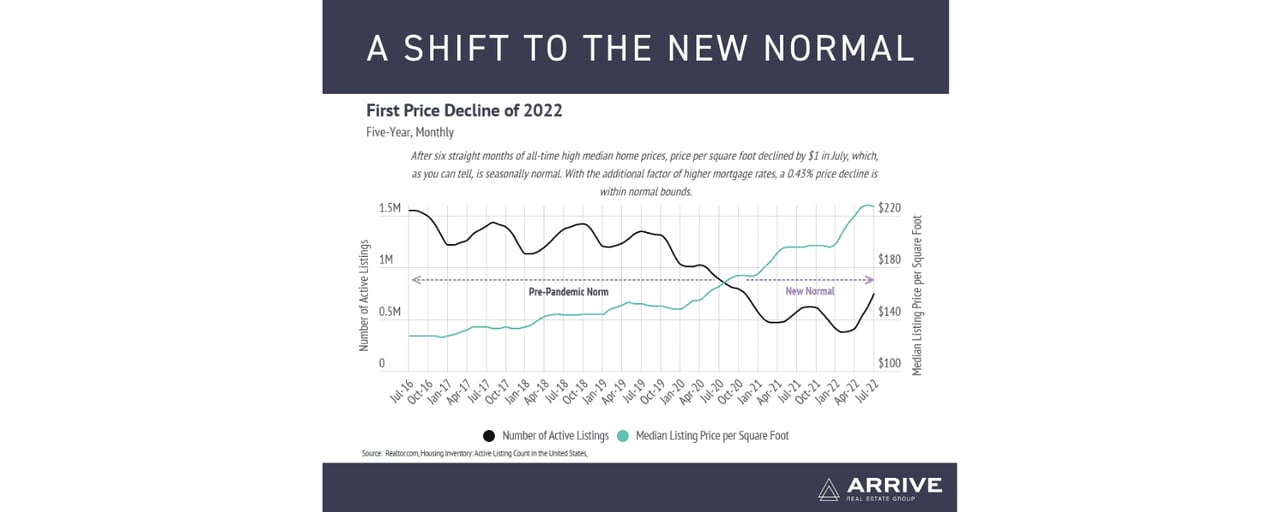Housing market recession? Depends on who you ask.
We knew the end of the streak was coming. Higher mortgage rates, which negatively affect affordability, combined with the typical summer sales slowdown and higher inventory have caused prices to decline month-over-month from the all-time high they reached in the spring. The National Association of Realtors (NAR) data show that the median home price in the United States declined by 2.4%, and Realtor.com data indicate that the median price per square foot declined by 0.43%. These aren’t major declines, as you can see, especially when considering the decline in sales. According to NAR, the number of homes sold dropped 5.9% month-over-month and 20.2% year-over-year, which is substantial but not necessarily unexpected. Home sales in 2020 and 2021 were the highest since the 2006 housing bubble burst, which set the stage for the 2008 financial crisis, and normal seasonal trends were less pronounced or non-existent. We weren’t sure how long the break in historic seasonality would last, but it seems to have ended, and seasonality has mostly returned.
As we look at the pre-pandemic seasonal trends, home prices and inventory increased in the first half of the year and declined in the back half. The trend is essentially two steps forward and one step back over and over, so even when the second half of the year sees some price decline, year-over-year prices tend to be higher. In July, we reached the longest-running streak of year-over-year home price increases on record, with 125 consecutive months. From January 2020 to June 2022, the median price per square foot rose 54%, so there is definitely room for some price declines in the back half of this year.
The monster price gains in 2020-2022 were, of course, pandemic related, and the already tight housing supply dropped to shockingly low levels. However, with fewer sales than expected and more new inventory coming to market, active listings have nearly doubled from the all-time low reached in February 2022. More inventory can only benefit the market, as we are still 44% below July 2019 (pre-pandemic) levels. Housing starts have declined since this past April as the cost of building has gone up. The National Association of Homebuilders’ Housing Market Index, which measures homebuilder sentiment for the single-family home market, has declined every month of 2022. These declines in sales and home building have led NAR Chief Economist Lawrence Yun to use the term “housing recession” with some caveats. We believe, however, that the word “recession” is too dark a picture for the current market. Although the market still favors sellers over buyers, we are moving toward a more balanced market, which feels like quite a switch given how deeply we dove into a sellers’ market since mid-2020. The market is getting healthier and a little less hot, which is ultimately beneficial to everyone participating when we look at the big picture.
The Local Lowdown
Prices tend to stagnate or decline slightly this time of year, which is exactly the case in the East Bay. The median single-family home prices declined month-over-month, continuing the downward trend from their spring peaks. Since May, single-family home prices have contracted by 20% in Alameda and 14% in Contra Costa. The price movements aren’t unexpected, as we are returning to more normal seasonal trends of price growth in the first half of the year and slight contraction in the second half. This is, of course, exacerbated by rising mortgage rates. Although the current average 30-year mortgage rate is still relatively low, the hyper-low rates we experienced in 2020 and 2021 allowed many more buyers to enter the market. We saw firsthand what happens when demand booms in an already undersupplied market: Home prices skyrocketed. When we link the price increases and seasonal trends with the 2.5% increase in 30-year mortgage rates, which increase the monthly mortgage payment by about 35%, we get a better picture of why sales have slowed and prices declined.
Single-family home sales increased month-over-month in August, while new listings declined, dropping inventory for the first time this year. The number of homes for sale has trended lower over the past three years and settled at lower levels, which is likely the new normal for housing inventory in the country. Generally, smaller supply equates to fewer sales. For example, if 500 homes sold last year, but there are only 300 homes for sale on the market this year, it’s awfully difficult to hit more than 300 sales. Although inventory grew higher than the record lows of 2021, 2022 has had one of the lowest inventories on record, so we were pleased to see that inventory is following historical seasonal trends. With the drop in inventory in August, the peak inventory level for 2022 will undoubtedly be one of the lowest on record.
Additionally, the huge number of sales in 2021 implies a sales slowdown in the future, and the future is now. On average, people move about 12 times in their lifetime in the United States, meaning if a million more people than average buy a home one year, there’s a decent chance about a million fewer people will buy a home the next. Homes are generally not something people continuously buy year after year.
As always, Arrive Real Estate Group remains committed to helping our clients achieve their current and future real estate goals. Our team of experienced professionals are happy to discuss the information we’ve shared in this newsletter. We welcome you to contact us with any questions about the current market or to request an evaluation of your home.

